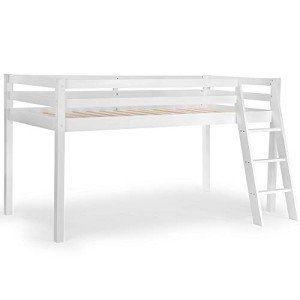The Comprehensive Guide to Bunk Beds House: Maximizing Space and Functionality
Bunk beds are ending up being increasingly popular in contemporary households, especially for those residing in limited space. Whether in a kid's bedroom, a guest room, and even a trip home, bunk beds supply an ingenious option for optimizing space while likewise accommodating numerous sleepers. This article explores the different elements of bunk beds, their design choices, advantages, and factors to consider for maintenance to assist anyone considering a bunk bed purchase make an informed decision.
Understanding Bunk Beds
Bunk beds are a kind of bed that includes one bed stacked on top of another, usually secured by a ladder or built-in stairs. They are typically made from wood or metal, with designs ranging from standard to modern. Bunk beds are most frequently used in kids's rooms, visitor accommodations, and summertime camps, but they can also be a great addition to studio apartments or homes.
Kinds Of Bunk Beds
Comprehending the varieties of bunk beds can help one select the right design for one's requirements. Here are the typical types:
| Type | Description | Pros | Cons |
|---|---|---|---|
| Standard Bunk | Two beds stacked on top of each other | Space-saving, classic design | Restricted sleeping capability for adults |
| Loft Bed | A bed raised with open space below for a work area or play location | Supplies extra functional space | Not ideal for more youthful children |
| Futon Bunk | A bed on top, often with a futon on the bottom | Versatile for sleeping and seating | Less stability compared to conventional bunks |
| L-Shaped Bunk | Two beds arranged in an L-shape, typically with storage options | Unique style, can fit in corners | Uses up more space than basic bunk beds |
| Triple Bunk | 3 beds organized vertically or in an unique configuration | Makes the most of sleeping space | Greater danger of accidents, more complex to make |
Benefits of Bunk Beds
Bunk beds provide many benefits, making them a useful furniture choice for numerous living spaces. The advantages include:
- Space Efficiency: Perfect for little rooms, they enable more flooring space, making it simpler to move around.
- Double Functionality: Especially in the case of loft-style beds, the space underneath can be used for a research study area, a play zone, or extra storage.
- Social Interaction: Bunk beds develop a sense of friendship amongst siblings or roomies, promoting sharing and bonding.
- Economical Sleeping Solution: They provide an affordable way to accommodate several visitors without the need to buy extra separate beds.
- Design Variety: With options ranging from streamlined modern-day designs to timeless wood structures, there is a bunk bed design to match any decor.
Crucial Considerations for Bunk Beds
While bunk beds provide numerous advantages, there are specific considerations to bear in mind to make sure security and durability:
- Weight Capacity: Always check the weight limitation of the bunk bed to avoid accidents. The majority of standard bunk beds have weight capabilities in between 200-400 pounds.
- Material Quality: Opt for long lasting products such as solid wood or high-grade metal to ensure stability and durability.
- Safety Features: Look for designs with guard rails on the leading bunk and large ladders. Guarantee that the bed feet are stable and safe and secure.
- Age Appropriateness: Young kids should not oversleep the top bunk, as the danger of falling is substantially increased.
- Assembly: Some bunk beds can be intricate to put together. Guarantee that good instructions are readily available, or think about expert assembly.
Maintenance of Bunk Beds
Proper upkeep of bunk beds is important for guaranteeing their convenience and security. Here are some tips for maintenance:
- Regular Inspections: Periodically examine the stability of the bed, ensuring all screws and elements are tight and secure.
- Cleaning: Dust the furnishings routinely and clean any spills immediately to maintain the stability and appearance of the beds.
- Bed mattress Care: Rotate mattresses regularly to avoid wear and sagging. Think about hypoallergenic mattress protectors for included comfort and tidiness.
- Readjust if Moved: If the bed is relocated, readjust all components to guarantee ongoing safety and stability.
Frequently Asked Questions about Bunk Beds
Q1: Are bunk beds safe for children?A1: Yes, as long as safety standards are stuck to. Guarantee the top bunk has guardrails, and that kids are old adequate and accountable enough to securely use the top bunk. Q2: How much weight can a bunk
bed support?A2: Most bunk beds support between 200 to 400 pounds per bed
, but this can vary by style. Constantly describe the producer's specifications. Q3: Can adults sleep in bunk beds?A3: Yes, numerous modern bunk beds are
designed to accommodate adults, especially those with enhanced frames. Q4: Do bunk beds need special mattresses?A4: Not always. Requirement mattresses can be utilized as long as they fit the
measurements provided by the producer. Nevertheless,
think about utilizing thinner mattresses for the leading bunk to guarantee safety clearance. Q5: How can I optimize space in a room with bunk beds?A5: Use the area underneath for storage or desks, and consider including vertical storage
options to keep the space uncluttered. Bunk beds provide an exceptional service for taking full advantage of space in a home while offering a trendy and functional sleeping plan. Whether for a kid's space, a visitor space, or a holiday house, they are a flexible option that can accommodate various requirements. By considering types, benefits, and correct maintenance, people can make informed decisions, making sure safety and durability in their bunk bed investment. With Bunk Beds Children's , bunk beds can boost both comfort and visual appeal in any space.

